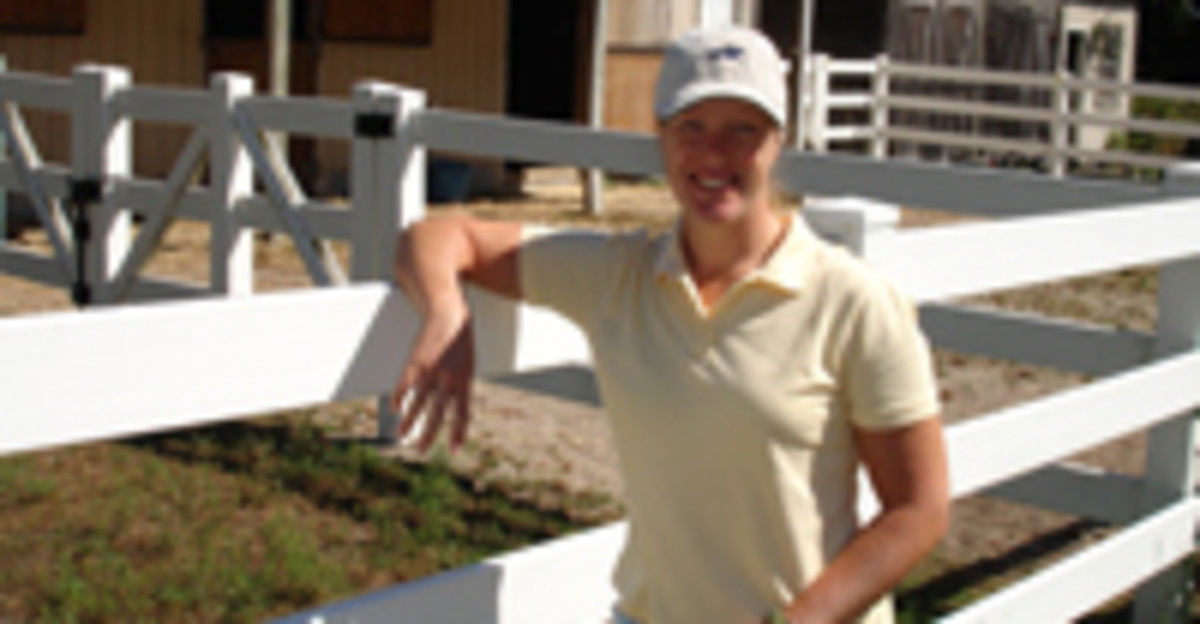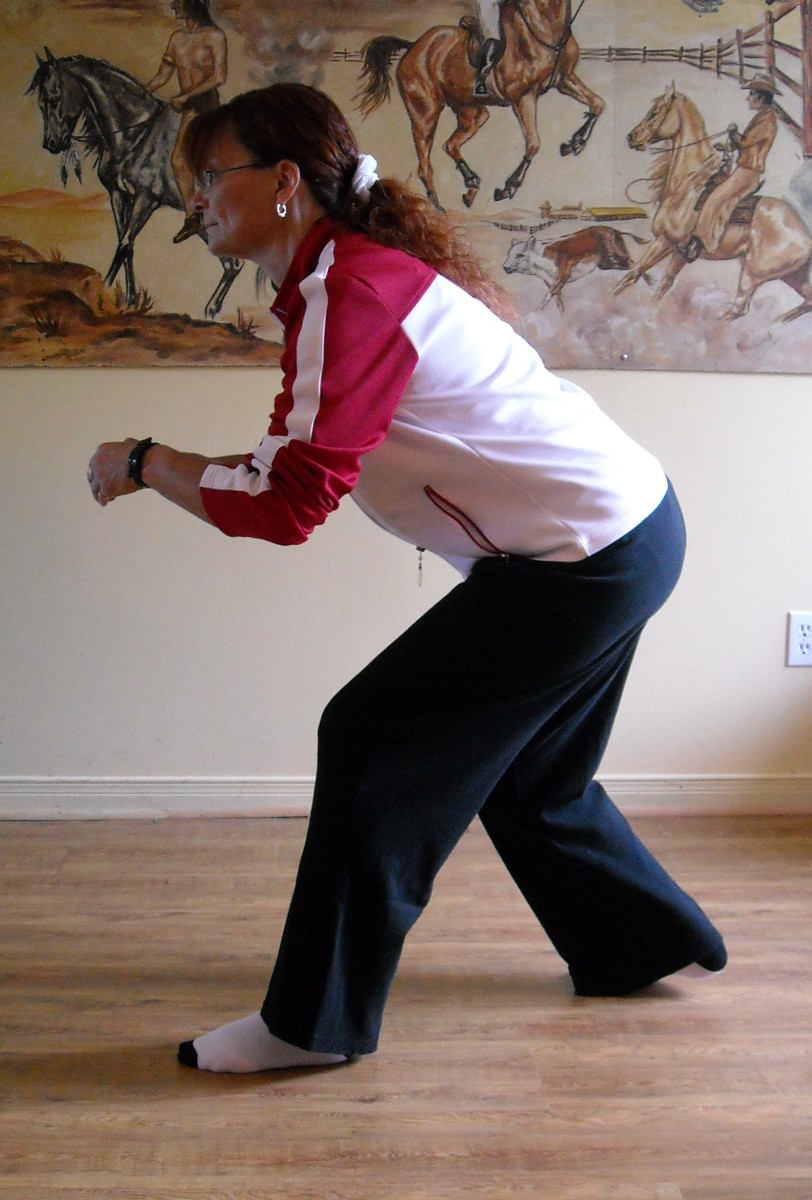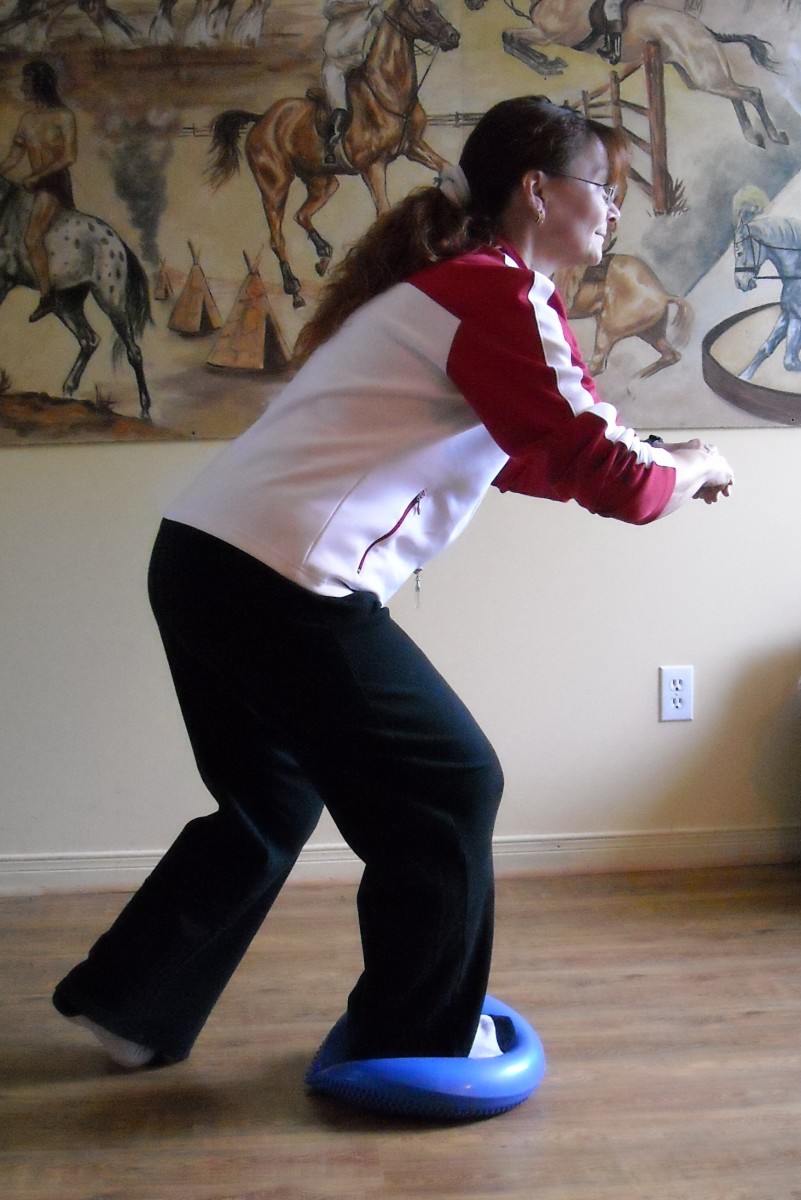Heather Sansom is the author of rider fitness ebooks Complete Core Workout for Rider, and a regular columnist in several equestrian publications including Dressage Today.?EquiFITT.com offers rider fitness clinics & workshops, Centered Riding? instruction, and convenient distance eCoaching for riders anywhere.? Subscribe to receive free monthly Equestrian Fittips, and download rider fitness eBooks at:??www.equifitt.com/resources.html

There are many ways to improve your dressage seat, and certainly the best way is to have good instruction with enough hours of accurate practice in the saddle.?? (Inaccurate practice reinforces inefficient muscle memory.)? However, many riders may only ride one or a couple of horses from 3-5 days a week and it is hard to improve their dressage seat.? A large percentage of riders may ride under instruction, but do not have the benefit of daily instruction.? Riders who may spend most of their day with their body in some other position (such as seated at a computer) are actually spending the majority of their time training their body for a posture and usage which may not be constructive to the desired performance in the saddle.
For example, long periods seated such as at a computer or in a car create imbalanced patterns across the hip joints from muscle and ligament tightness, and lack of use (weakness).? The seated pelvis is being trained to be static, and is prejudiced against correct movement because of the muscle imbalances and lack of stimulus from holding a seated posture.? The pelvis that is physically pre-disposed to ineffective muscle engagement and movement, puts the rider at a disadvantage for their ride.
The human body is designed to work best in balance.? The human body seated on a horse has optimal biomechanics, when the correct muscle chains act at the correct moments, with correct force to support the rider’s skeletal structure and support the desired movements. ?The rider’s body has less chance of responding correctly when it comes to the ride with imbalances or pre-disposed tendency to incorrect muscle engagement.? Common examples are often over-engagement in areas such as the hip flexors (pulling the leg forward) or lack of engagement in the lumbo-pelvic area.
If the rider’s lower back extensors and lateral stabilizers (gluteus medius on the side of the hips) have been overloaded or stretched all day and inactive from prolonged seated postures (chairs, car), they will not engage correctly during the ride to support the rider’s hips and spine for correct posture.? Of course, posture for a rider must be understood as posture-in-motion or dynamic balance because of the constant micro-adjustments which occur to maintain self-carriage on a moving horse.
Lack of stimulation to important postural stabilizers causes the reaction ability of the muscles to be reduced.? The neuromuscular connection is weakened.? Neuromuscular connections can be thought of like electrical impulse connections or even more simply like a cell-phone connection.? A connection with interruption or interference creates ?packet loss’ on the phone call- you can only hear every other word.? Weakened or broken neuromuscular connections are similar.? Your brain can even forget to recruit some muscles.? “Move it or lose it” really is a fairly accurate common expression that applies to training.
A disconnection or lack of correct engagement of stabilizers in the rider’s pelvis can result in issues such as difficulty with leg aids, a collapsing lower back, weakness in lateral movement and even an overactive low back resulting in back strain and pain.
Unfortunately, it is not good enough for your horse to ?hear’ intermittent signals from your seat.? Intermittent engagement of stabilizers in the pelvis also leaves your spine unsupported, and your back at much greater risk for a strain injury.? If the muscle has insufficient stimulation, it will atrophy.? So, the goals of training postural stabilizers are two-fold:
- Wake up the muscle area- re-establish a strong neuromuscular connection.
- Build endurance and strength so that your body can respond to the demands of your ride with ease.? You should never have to think about maintaining posture or applying muscular force during your ride.
Training the stabilizers in a rider’s pelvis helps pre-condition the rider’s body to have the capacity and ability to do the right things.?? You can improve your seat by using groundwork to prepare your body to carry and use itself more appropriately when you are in the saddle.
Even if you ride several hours every day, you can greatly reduce your risk of strain injury by including some groundwork in your schedule.?? Groundwork designed for humans, balances the human body best.? Just riding does place demand on your body which does create some strength.? However, it is very common for riders (especially professionals who spend many hours in the saddle a day) who do not have their own conditioning exercises, to experience significant strain issues over time.? In effect their body has had to work overtime to absorb the motion of an animal at least eight times their body-weight, for thousands of repetitions.
A rider interested in bringing maximum self-carriage to their ride, avoiding injury and prolonging their riding career should do some ground training. ??Riding is a sport that can be engaged in right in to senior years, and riders can improve their entire life.? This means that a rider can be improving technically, at an age when their physical preparedness for sport is actually reducing due to the normal aging process which reduces suppleness in ligaments and causes muscle fibre atrophy.? Riders over 40 should definitely be engaging in supplementary exercises to strengthen the muscles that stabilize the pelvis and spine, so that the riding itself does not actually wear your body down.? Most riders want to be able to ride as long in life as they possibly can.
Even though concepts of biomechanics and neuromuscular connections can seem complicated, the great news is that it is actually fairly easy to help your body create the right muscle engagement to support a better seat and spine position.

Three easy exercises that have multiple benefits and help in these areas are the single leg hip-hinge, side plank and side leg raise.? Because riding involves a lot of endurance (sustained engagement of muscles during various exercises), it can be especially beneficial to do these exercises as isometric.? In simple terms, get into the exercise position and hold the position.? When holding the positions for up to 60 seconds is easier, you are ready to progress to more advanced versions using balance challenging techniques that further stimulate your core and prepare you for stabilizing your pelvisand spine in dynamic motion such as you must do on the horse.
Hip Hinge
The hip-hinge creates correct muscle firing patterns in your gluteals (seat), core area supporting your lower back, and hip stabilizers.? The primary area strengthened is your gluteals, with additional strengthening for the thighs.? Even though the torso tips forward, keeping your core engaged and your spine neutral creates strength and correct engagement for the muscles that support your lower back in the upright riding posture.
Start: Step back and lower your weight into a mini-squat, with your seatbones poking backward.? Keep your chest and head up so that your back ?hinges’ as well.? Keep most of your weight in the front leg, and keep your back flat.? When you are starting out, make the movement very small and repeat a dozen times, daily.? As you get stronger, you can increase the number of repetitions, but only do them every other day.? You can also build stamina by holding the position for several seconds before releasing and repeating.
Advanced Version😕 Introduce more balance challenging elements such as standing on a cushion or Bosu ? or raising one leg in the air.
Add a side plank: The side plank primarily strengthens lateral stabilizers in the torso and hips.? It also improves strength in the overall core area by engaging your transverse abdominus- the deep inner core muscle that supports your torso like a natural corset.? Side planks have the added bonus benefit of strengthening the shoulders, which is especially helpful in injury avoidance for women.?Lie on your side with your knees, hips and shoulders aligned (knees bent).? Lift yourself up onto your elbow, maintaining alignment from your shoulders-hips-heels.? Progressions could include a full leg side plank, or raising yourself up onto your hand.? Work your way up to being able to hold the plank with good alignment for 60 seconds before introducing additional variables and challenges to your core control.

Advanced Versions:?Add a destabilizing surface at your feet or shoulders using a cushion, balance board or other balance device. Or, add a side leg raise: The primary focus of this exercise is the gluteus medius (hip area) which factors in to supporting strong leg aids as well as symmetry in the saddle from left to right.? Performed with correct alignment from shoulder to hip to heel, the side leg raise engages all the postural core muscles used in maintaining nice upright alignment in the saddle.
Heather Sansom is the author of rider fitness ebooks Complete Core Workout for Rider, and a regular columnist in several equestrian publications including Dressage Today.?EquiFITT.com offers rider fitness clinics & workshops, Centered Riding? instruction, and convenient distance eCoaching for riders anywhere.? Subscribe to receive free monthly Equestrian Fittips, and download rider fitness eBooks at:??www.equifitt.com/resources.html











